Shopify Review: Is It the Right eCommerce Platform for You? (Read This First)

Two things pop into my mind when someone says the word “eCommerce”: WooCommerce or Shopify.
We have talked about WooCommerce on this website before, and you can find an extensive review about it.
But this post is not about WooCommerce.
The point of this article is to give you an all-inclusive Shopify review, so you can decide if it’s a great fit for you.
We have a lot of things to go through, so let’s go!
Shopify Review at Glance
| Ease of Use: 5/5 | Features: 4/5 | Pricing: 4/5 | Support: 5/5 |
| Pros: | Cons: |
| All-in-one solution | Transaction fees |
| Easy to use | The cost of some apps and themes |
| Pricing (the platform) | No proper category system |
| Numerous ways to sell | Products can only have three options |
| Customer service | |
| Security | |
| Store management | |
| Shopify Shipping | |
| Store account |
The Verdict
Shopify is an all-in-one solution, offering everything in one package: Hosting, security, customer support, web design, and a blogging platform. They even handle the payment gateways.
The eCommerce platform is user-friendly, and you don’t have to worry about technical questions like you do in self-hosted solutions.
Just pay attention to the product categorization system and app pricing. Especially in the latter, as you may run the risk of increasing your monthly running costs if you are not careful.
What is Shopify?
In 2006, Tobias Lütke and Scott Lake had a problem: they wanted to start selling snowboards online, but the task became challenging. None of the current eCommerce solutions at the time were a good fit for them.
Empowered by the situation, Lütke decided to build his own eCommerce solution, and Shopify was born.
Enter today:
Shopify has become the go-to eCommerce platform for many, and it powers over 1,700,000 businesses around the globe. More than 5,000 workers work for the company.
It’s an all-in-one solution that allows you to build an online store from start to finish without ever leaving the Shopify interface.
Shopify considerably lowers the level of building an online store. It means that even an average store owner can design and build their website with simple point-and-click maneuvers without hiring a web developer.
Getting Started with Shopify
Setting up a Shopify store is very easy.
First, you go to the Shopify website and click on the Start free trial button on the top-right:
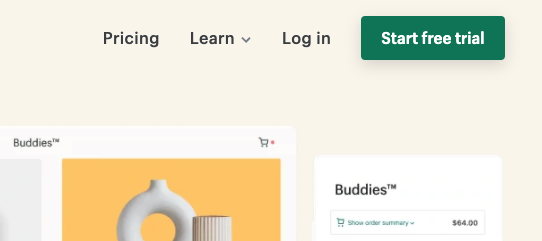
Then, enter your personal information on the next view and click the Create your store button:
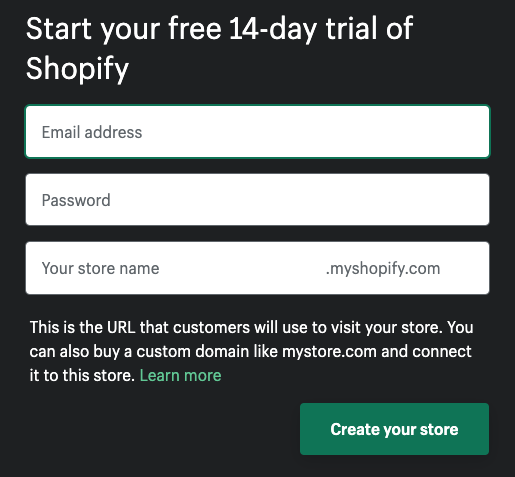
Next, Shopify asks a bit about your store and what you are going to sell:
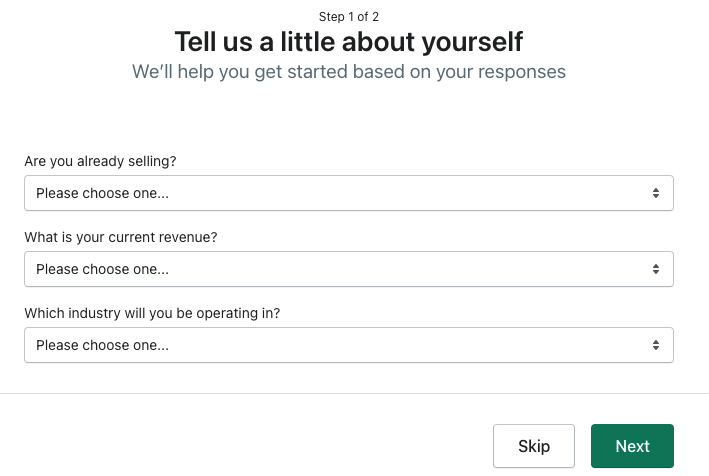
Finally, enter your address information, so you get paid:
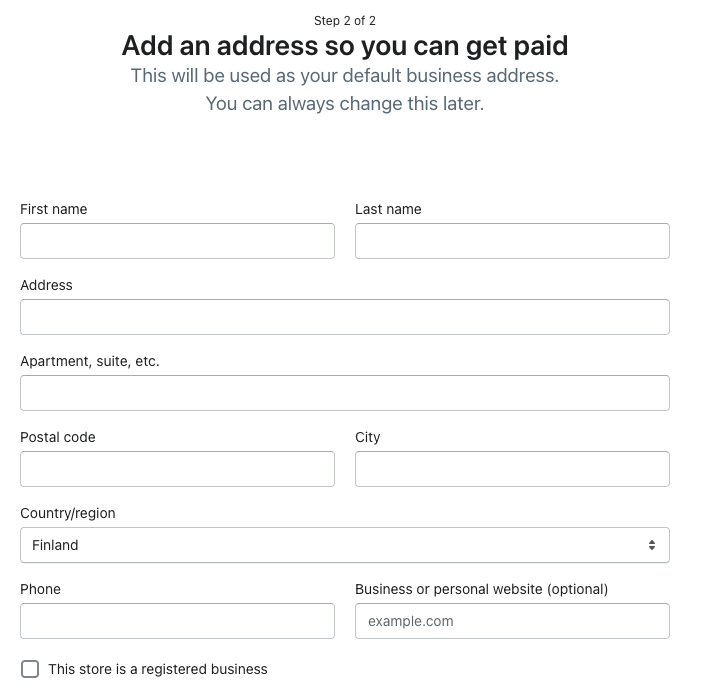
Once you have entered all the necessary information, click Enter my store, and you’ll land at your brand-new eCommerce store.
In general, setting up a store is a quick and straightforward thing to do. Everything is straight to the point in this process, and you can start with Shopify in a few minutes.
Ease of Use
User Interface and Usability
After you have finished the initial setup, you’ll land on the admin view, where you create products and get an overview of your store.
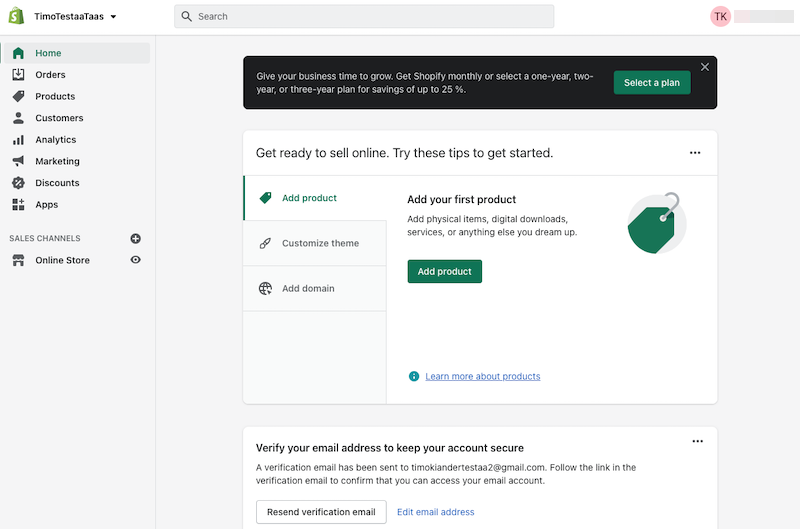
You can find the main navigation on the left. From there, you can quickly move around on the platform from one section to another. For instance, you can find orders, products, and customer management from that menu.
You can also find site-related management tools on the left side of the page, under the Sales Channels menu item. From there, you can access blog posts, pages, navigation, and other preferences.
Under Sales Channels, you can access themes that define the outlook of your site.
Layout Options
The default theme looks surprisingly good, which is great if you’re starting out with Shopify.
It’s also easy to customize the theme with Shopify Sections. This is a drag-and-drop page builder feature built into the interface’s theme customizer.
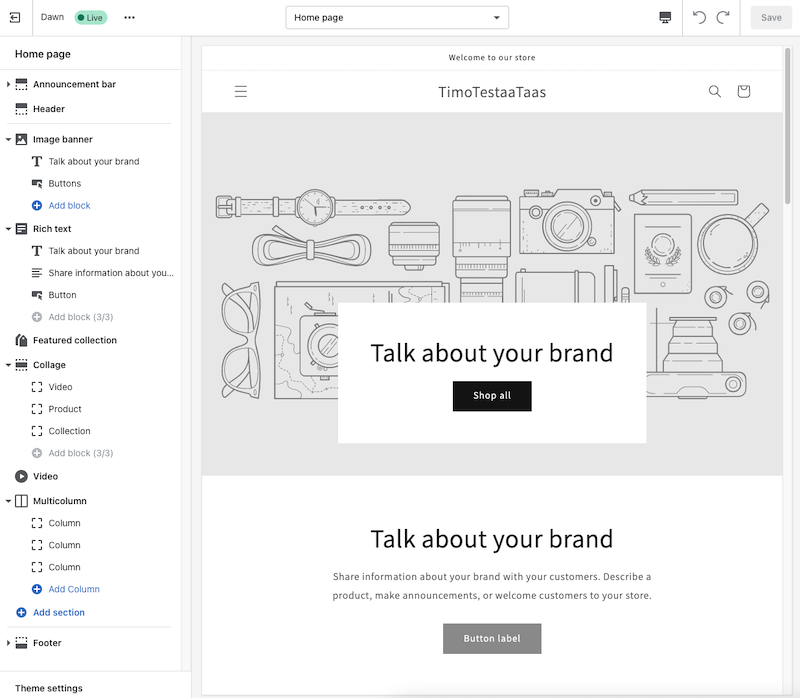
The customizer allows you to add featured products, featured collections, blog posts, and more without knowing how to code. The only downfall is that there’s no element to add a header with a call-to-action.
You can also purchase many different themes if you don’t like the default template or wish to extend the number of features you can access.
These themes are available in the theme store, which has a decent selection of free themes. This store also provides an opportunity to developers looking for a new marketplace to sell to.
Adding Products
The Shopify interface is easy to use, especially when adding products. You can add a title, description, images, prices, SKUs/barcodes, shipping options and variants – all on one page.
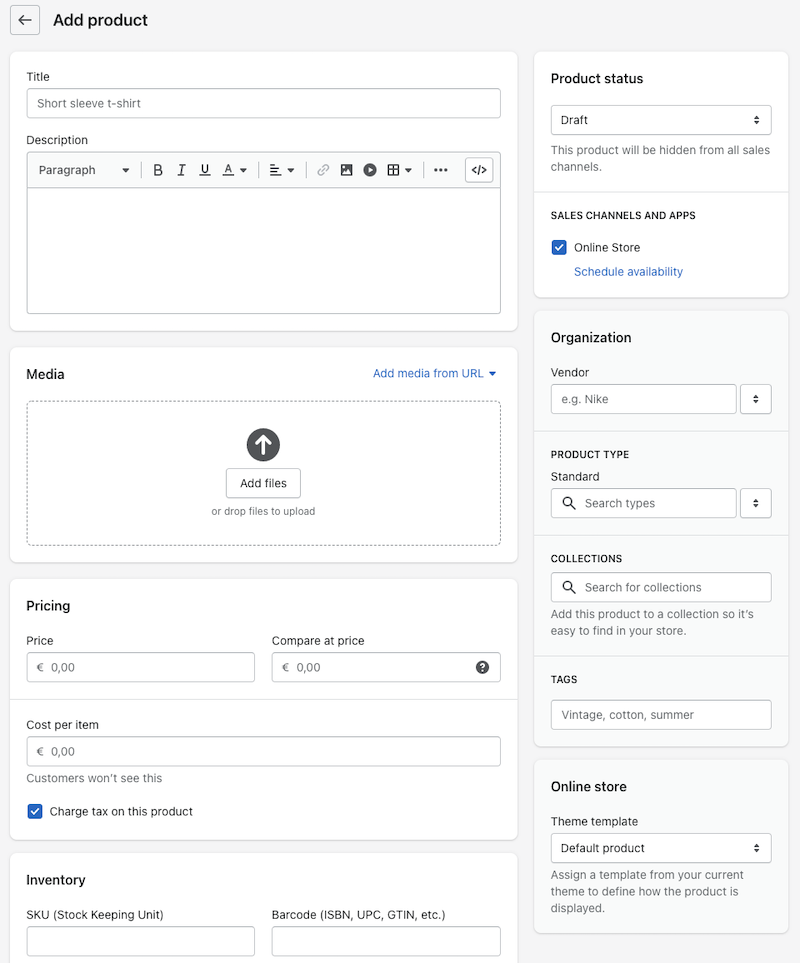
While adding products is simple, Shopify should improve certain common functionality.
First, while you can create collections (or categories) easily in Shopify, creating subcategories is confusing.
Categorization is basic functionality for any online store, and it keeps your store organized. They also improve the user experience.
You can also add subcategories (or collections), but unfortunately, this is tricky. In fact, I had to find YouTube videos or read tutorials on how to do it.
Second, while you can have 100 variants per product, you can only have three options.
Options and variants form a parent/child relationship. For example, color is an option, and black, white, and red are the variants.
While you can have three options per product, these options are different from product to product.
For example, one product can have options like size and color, while the other has weight and material. But thanks to the limitation, having size, color, weight, and material as options for a single product is impossible.
Shopify Top-5 Features
1. Sales Channels
While Shopify is a dedicated eCommerce solution that hosts your store for you, you still have multiple ways to sell with it.
For example, you can sell with Shopify POS. This feature allows you to accept credit cards in person, essentially allowing you to blend physical sales with your eCommerce ventures.
You can also sell on social media without redirecting customers to your site. They’ll complete their orders directly on the social media platform they’re using.
This feature is available for Pinterest, Twitter, and Facebook.
2. Security
Shopify handles all the technical matters for you, including security.
They’re PCI compliant on a Level 1 basis, offering free SSL certificates on all premium plans. They even have a reputation for maintaining a 99.99% uptime performance on average.
Shopify also complies with all six PCI standard categories to give your online store the best security. These categories include maintaining a secure network, protecting cardholder data, or regularly monitoring and testing networks.
3. Shopify Shipping
Shopify offers discounted shipping label rates for those who ship with the United States, Canada, United Kingdom, or Australia.
You can also buy and print labels from inside the Shopify admin panel. Therefore, you can print labels in advance, saving you time at the post office.
Finally, you can define shipping zones and rates to give customers accurate shipping quotes.
4. Staff Accounts
Shopify offers staff accounts for teams.
You can create different accounts for different team members and give or withhold specific allowances to each account.
There are two accounts in the Basic plan, five on the Shopify plan and 15 on the Advanced plan.
5. Store Management
Shopify allows you to keep track of several different things.
For instance, you can monitor abandoned carts and enable notifications that send an alert whenever someone places an order. You can also keep track of customers in the Customers section.
The most powerful and detailed store management parts are the Reports and Dashboard sections under the Analytics menu.
The Reports section contains a lot of information that breaks down the sales you receive. Sales are broken down by month, product, hour, product variant, SKU, vendor, and more.
You’ll also see reports on customer acquisitions, so you know how well your marketing campaigns are working. You’ll even be able to view a summary of your finances regarding sales, taxes, and payments.
The Dashboard section contains important analytics for your site. These include specific information on where your customers come from and your top landing pages.
Extensibility and Integrations
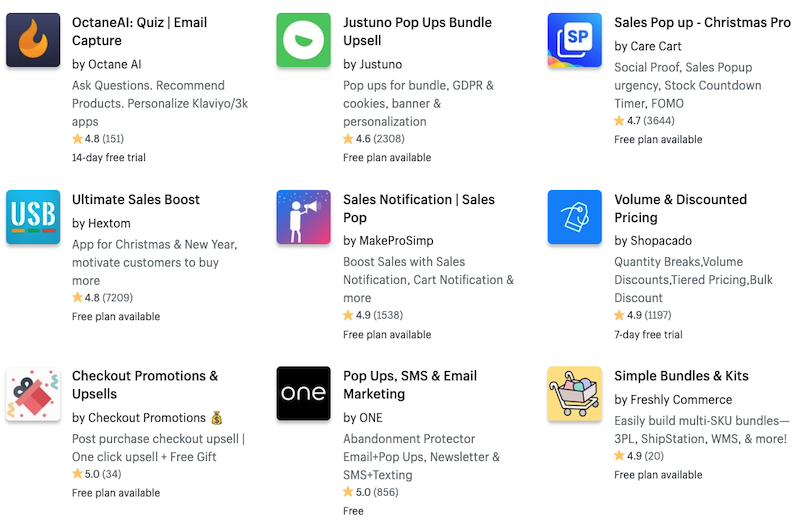
One powerful feature that Shopify has is its extensibility. You can easily expand your online store with apps.
The Shopify App Store contains over 3200 apps, which are created either by Shopify or a third-party developer. You can find apps in various categories, including conversion, marketing, store design, or customer service.
But before you install any add-ons, make sure you understand how the app support and the pricing works.
For example, the apps created by Shopify are supported by Shopify, but support options for third-party apps may vary.
The pricing varies, depending on the developer (Shopify/third-party), and we will discuss this next.
Pricing
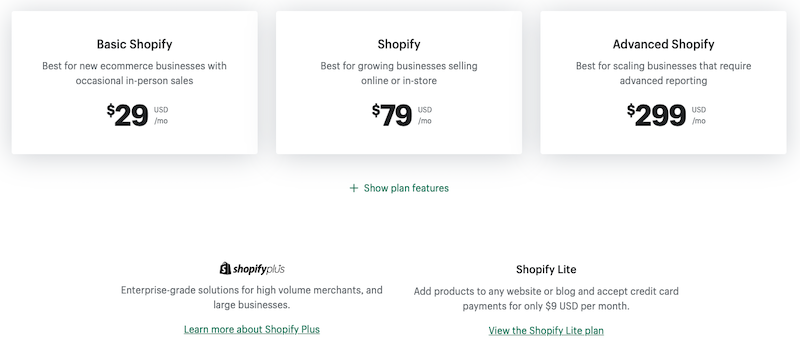
Shopify seems pricey at first glance, but their pricing makes sense.
The least expensive plan is Shopify Lite, available at $9/month.
This plan doesn’t offer hosting or even an entire website. Still, it does allow you to sell on your website or a number of different external platforms, including a physical location. You can even use it to send invoices.
If you want to feel the authentic Shopify experience, you can upgrade to the Basic plan. This plan costs 29 USD/month.
It gives you the full hosting capabilities of Shopify, combined with the tools that help you create your first online store and a blog.
If you want more features, the next plan you should consider is Shopify, costing 79 USD/month. This plan builds on top of the Basic plan, including more staff accounts (five), standard reporting, and shipping discounts up to 88%.
Want even more and better features? Then Advanced Shopify is your choice, costing 299 USD/month.
With this plan, you get lower Shopify Payment rates and transaction fees. The plan also gives you better tools for selling globally than the Shopify Basic or Shopify plans.
Finally, there is a Shopify Plus plan. It’s for enterprises, and companies like Heinz or Rothy’s are using it.
So, if you feel that Shopify Plus would be the best fit for you, you should contact Shopify directly for more information.
While the plans may look pricey, you save by picking the longer contracts.
For instance, the pricing structure for Basic Shopify looks like this:
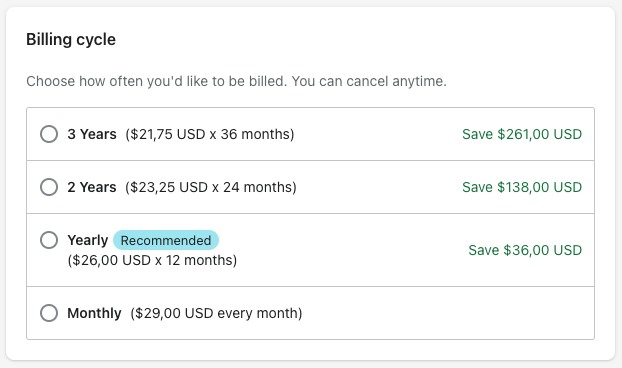
The longer you are willing to commit yourself to Shopify at once, the less it will cost you.
If you are still uncertain about Shopify, you can test it for free for 14-days without a credit card.
Transaction Fees
All plans use Shopify Payments by default, which Stripe powers. An order placed with a credit card has a transaction fee as high as 2.9% + $0.30. This amount lowers with a more premium plan but only just.
The platform will charge as much as 2% per transaction if you use a payment gateway outside of Shopify Payments, such as PayPal.
This charge is in addition to the credit card fee other payment gateways charge, which means you could pay as much as 4.9% + $0.30 per transaction.
Apps
The apps created by Shopify are usually free, and Shopify supports them. However, the third-party apps may contain a fee, and some are even pretty expensive.
You will pay a monthly fee for apps. This payment will come on top of the monthly subscription costs. Just pay close attention to this factor so that your running costs won’t skyrocket.
Customer Service
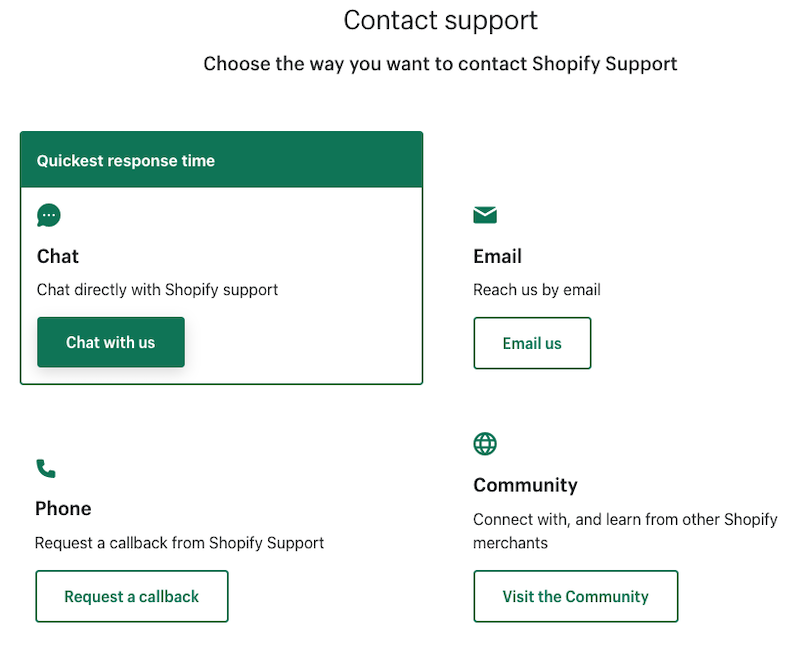
Shopify offers many ways to get support for your requests.
You can use email, community, or phone to reach them. Shopify also has a vast knowledge base you can explore to find answers to your questions.
What’s great about the support is that it offers a chat option. This channel is by far the best way to get answers to your questions fast.
For instance, I had a question about the transaction fees, so I asked directly about that from the support person. He gave me prompt answers, and I got the thing sorted out much faster than through a regular ticket workflow.
FAQ
Yes, it is.
Since Shopify is cloud-based, you don’t have to worry about the basic infrastructure: The hosting, security updates, apps, and themes – it’s all there. And if you run into questions, customer support is there for you.
Also, getting started with the platform is very easy, and you have a barebones structure of your online store up and running in minutes.
Just remember this: Your part is to provide the content, and Shopify takes care of the rest.
Currently, you can use Shopify Payments in 15+ countries.
Bear in mind that even if Shopify Payments supports your country, there can be prohibited businesses per-country basis.
Yes, it is.
Shopify is available in over 20 languages, covering many language regions worldwide.
This factor depends on the theme. While the themes created by Shopify are free, you can also purchase third-party themes, which can cost hundreds of US dollars.
The Conclusion: Is Shopify the Right eCommerce Platform for You?
Shopify is for first-time sellers and sellers with basic products with few variants.
If you have products that need proper subcategories, you may want to consider hosting your store elsewhere. Adding this functionality to a Shopify store with an app will add an additional $10/month to your monthly fee.
The platform is also not suitable for sellers who sell products that come in various options. This includes sellers who use a “build your own” feature in their stores.
If you only plan on selling simple products and do not want to go through the hassle of hiring a web designer and other entities to help you manage your store, Shopify is definitely worth a try.
But now, over to you:
Have you used Shopify, and what do you think about it? Share your thoughts in the comments section below.

Leave a Reply